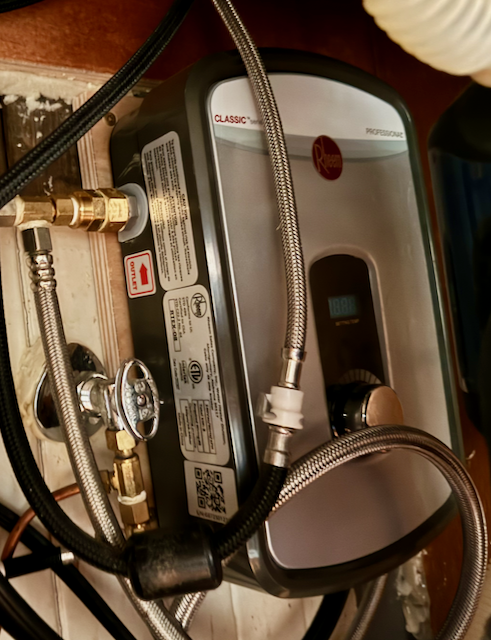Under-sink Water Heater
This is the first of two posts about heating water in our kitchen. This post is about the tankless water heater I installed under our kitchen sink. The second post will cover how to make electric kettles fast in the US.
My starting point is our 130-year old San Francisco victorian house. The water heater is in the garage on the ground floor and our kitchen is on the 2nd floor. I assume the hot water pipes were retrofitted at some point, and they take a meandering route from one side of the house to the other before making their way to the kitchen, including a run on the outside of the building envelope where they’re only haphazardly insulated (I added the insulation). This meant a wait of several minutes from turning on the hot faucet to when actual hot water came out (and yes, lots of wasted water)1.
The hot water lines to different parts of the house also don’t form a “loop”, and instead branch out close to the water heater, with independent lines going to the kitchen, washer and bathrooms. With that in mind I didn’t want to install a hot water recirculation system: It would only really have helped in one place and the energy loss from hot water continuously circulating in pipes outside the house would have been severe.
Instead I chose to install an 8kW 240V Rheem tankless water heater under the kitchen sink. Since I was already running 240V 40A power lines for our new induction range, adding another set of wires for the water heater wasn’t too bad. The heater is pretty compact and fitting it under the kitchen sink was fiddly but ultimately not a problem.

Online reviews for these types of units are very mixed. People (understandably) are not happy if their showers are cold. But for us, in this one-sink application, the heater produces very hot water instantly. The thermostat is not even cranked up all the way and I don’t think we rely on the full 8kW. Importantly, our cold-water inlet temperature here in San Francisco is relatively high (“almost tepid” is how I’d describe it) which means the heater has less work to do. In retrospect a 30A, or maybe even 20A model, would probably have been adequate.
I plumbed the water heater to the cold water line and capped off the hot water line under the sink rather than putting the tankless heater inline with the hot water from the garage. It takes so long for the garage hot water to make it to the kitchen that I don’t think there’s anything to be gained from letting the garage hot water “take over” from the tankless heater when the hot faucet runs for a while.
I also plumbed our dishwasher to the tankless water heater. As predicted by another Technology Connections episode this has significantly improved cleaning performance. That’s because, for its initial pre-wash rinse, the dishwasher doesn’t use its heater and just hopes that it’s supplied with hot water. That is now actually the case, making the initial rinse much more effective.
Overall I’m very happy with this little water heater. Having instant hot water for washing hands and rinsing dishes seems like a bedrock of modern civilization but we were without it since moving here in 2017. If you can make the required 240V high-current electrical circuit happen and maybe also if your cold water inlet temperature is not too low then I think under-sink tankless water heaters are a no-brainer for solving the problem of having to wait for hot water.
- I would love to travel back in time and relive the scene when the hot water system was originally installed in our house. I imagine the plumber and the then condo owners standing in the kitchen after the work was complete, turning on the hot water and then waiting in eager anticipation for several long minutes for the water to start turning hot. Did they then pop a bottle of champagne? Did anyone comment on whether waiting this long was actually practical when doing common kitchen tasks? We’ll never know. ↩︎
Leave a Reply